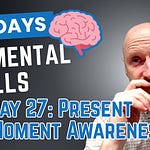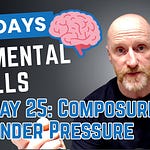We’ve all felt anxiety at some point in our lives, the apprehension associated with possible adverse future outcomes. It’s usually associated with something important to us, like performing well in a job interview, going to a social event with people that we’re uncomfortable being around, or running our first marathon. We hope things will go well, but we’re uneasy about the unknown and imagine something different. Depending on the person, it can be mild, like butterflies in your stomach. To others, is can become chronic and completely debilitating. Individual differences count, and so too does past experience. Still, essentially, it is our thoughts about the future and our perceived potential for failure that have the most significant influence on the intensity and duration of anxiety we feel. If you want to perform to your best, understanding and managing anxiety is critical.
What Is Anxiety?
Anxiety is a natural response to perceived threat or danger, characterised by a range of emotional, cognitive, and physiological symptoms. While short-term anxiety can be helpful, allowing you to respond quickly to potential harm, chronic or excessive anxiety impairs healthy functioning. At its worst, prolonged anxiety can lead to physiological illness and psychological disorders. If we can understand anxiety, we may be better able to mitigate against it. Perspectives include neurological, psychological, and physiological mechanisms at work in its presentations. Each perspective offers distinct insights into how anxiety arises, how you experience it, and how you can effectively treat it. Cognitive Behavioural approaches can be very helpful, and you don’t necessarily need a professional practitioner to help you here; you can execute these strategies yourself. Exercise can also have a positive effect.
A paper by Severinsen & Pedersine (2020)1 reported that physical exercise has positive health effects on cognitive function and brain health. Through the muscle’s production of Myokines, they say that physical activity can decrease the rate of cognitive decline in healthy people and in people with neurodegenerative disorders across the life span. Physical exercise has a positive impact on stress, anxiety, and depression, they report. Other studies have shown that an active lifestyle is associated with improved learning and memory, enhanced executive functions, better language skills, faster reaction times, higher academic achievement in children, and increased intelligence in adolescents. Physical activity also has beneficial effects on appetite, sleep, and mood. Difficult and challenging workouts also build resilience to stress.
The Neurological Perspective on Anxiety
From a neurological standpoint, anxiety is rooted in the functioning of several brain structures and neurotransmitter systems responsible for emotional regulation and threat detection. The amygdala, the fear centre, plays a central role in the processing of apparent threat. In anxiety disorders, hyperactivity in the amygdala leads to exaggerated responses to perceived dangers, even in safe situations (Etkin & Wager, 2007)2. This over-activation is often accompanied by insufficient regulation from the prefrontal cortex, which is responsible for executive control and emotional regulation (Bishop, 2007)3. When the prefrontal cortex fails to inhibit the amygdala effectively, anxiety symptoms can intensify. What we mean here in practical terms is, the capacity to become accept conditions as they are, and to realise the threat is mostly imagined, not real.
The hippocampus, which plays a crucial role in contextual memory and learning, is also implicated. Dysfunction in the hippocampus may lead to overgeneralisation of fear responses—responding with anxiety to cues that resemble, but are not identical to, previous threats. Neurotransmitters such as gamma-aminobutyric acid (GABA), serotonin, and noradrenaline are also key. GABA is the brain’s primary inhibitory neurotransmitter and is responsible for dampening neural excitability. Low levels of GABA are associated with heightened anxiety. Similarly, imbalances in serotonin and noradrenaline systems can lead to increased arousal, poor mood regulation, and hyper-vigilance. Diet can impact neurotransmitter regulation. Exercise also impacts their production in the brain.
Summary:
Amygdala hyperactivity and poor prefrontal regulation contribute to anxiety.
Hippocampal dysfunction leads to fear generalisation.
Low GABA and serotonin levels increase emotional reactivity.
The Psychological Perspective on Anxiety
Psychological theories of anxiety focus on the mental and behavioural processes that contribute to the onset and maintenance of anxious states. Cognitive theory, as proposed by Beck (1976)4, suggests that individuals with anxiety disorders engage in maladaptive thinking patterns, such as catastrophising or selectively attending to threat-related information and ignoring information that supports alternative possible future outcomes. These cognitive distortions amplify perceived danger and fuel anxiety.
Learning theories also explain how anxiety can be acquired and sustained. Through classical conditioning, neutral stimuli can become associated with fear if they occur in conjunction with traumatic events. Operant conditioning plays a role in the maintenance of anxiety, as avoidance behaviours are negatively reinforced by the temporary relief they bring, preventing fear extinction.
Trait anxiety—a stable predisposition to perceive situations as threatening—is another factor, as is early life experience. Insecure attachment styles and early trauma can compromise emotional regulation and increase vulnerability to anxiety in later life (Mikulincer & Shaver, 2007)5. Intolerance of uncertainty, often observed in generalised anxiety disorder (GAD), further contributes by making ambiguous or unpredictable situations especially distressing (Dugas et al., 1998)6.
Summary:
Cognitive distortions maintain anxiety.
Anxiety can be learned through conditioning.
Trait anxiety and early trauma increase vulnerability.
Physiological Perspective
Physiologically, anxiety is manifested through activation of the autonomic nervous system (ANS), particularly the sympathetic branch, which prepares the body for “fight or flight”. In response to a perceived threat, heart rate increases, breathing becomes rapid, muscles tense, and digestion slows. These responses are adaptive in acute situations but become problematic when they persist without real danger.
The parasympathetic nervous system, which promotes rest and recovery, is often underactive in individuals with chronic anxiety. This imbalance can lead to sustained physiological arousal and long-term health consequences. The hypothalamic–Pituitary–Adrenal (HPA) axis also plays a critical role, releasing cortisol in response to stress. Chronic activation of the HPA axis, as observed in anxiety disorders, can impair immune function, memory, and emotional regulation (Sapolsky, 2000)7.
Common somatic symptoms of anxiety include muscle tension, fatigue, dizziness, sweating, and gastrointestinal disturbances. These symptoms are not only distressing in themselves but also serve to reinforce anxious thoughts, creating a feedback loop.
Summary:
Autonomic Nervous System (ANS) activation leads to fight-flight-freeze responses.
The Hypocampal-Pituitary-Adrenal (HPA) axis releases cortisol, affecting health.
Somatic symptoms reinforce anxious thoughts.
Conclusion
Anxiety is a multifaceted phenomenon involving brain structures, cognitive processes, and bodily systems. The neurological perspective highlights dysregulation in emotional circuits and neurotransmitter imbalances. The psychological perspective underscores maladaptive thought patterns, learned behaviour, and personality traits. The physiological perspective focuses on the body’s stress response systems. Together, these perspectives offer a comprehensive framework for understanding anxiety and inform integrated treatment approaches involving medication, psychotherapy, and lifestyle modification.
Mental Skills Basics Course
Suffering stress and anxiety is not a prerequisite for success in self-employment–there's a better way. Mental skills provide you with the means of coping effectively with difficulty and achieving your goals. I created the Mental Skills Basics Course to introduce business leaders, self-employed individuals, freelancers, consultants, and small business owners to the psychological and emotional skills associated with success.
References
Severinsen, M. C. K., & Pedersen, B. K. (2020). Muscle–organ crosstalk: the emerging roles of myokines. Endocrine reviews, 41(4), 594-609.
Etkin, A., & Wager, T. D. (2007). Functional neuroimaging of anxiety: a meta-analysis of emotional processing in PTSD, social anxiety disorder, and specific phobia. American Journal of Psychiatry, 164(10), 1476-1488.
Bishop, S. J. (2007). Neurocognitive mechanisms of anxiety: An integrative account. Trends in Cognitive Sciences, 11(7), 307–316
Beck, A. T. (1976). Cognitive therapy and the emotional disorders. New York: International Universities Press.
Mikulincer, M., & Shaver, P. R. (2007). Attachment in adulthood: Structure, dynamics, and change. New York: Guilford Press.
Dugas, M. J., Gagnon, F., Ladouceur, R., & Freeston, M. H. (1998). Generalized anxiety disorder: A preliminary test of a conceptual model. Behaviour Research and Therapy
Sapolsky, R. M. (2000). Glucocorticoids and hippocampal atrophy in neuropsychiatric disorders. Archives of General Psychiatry, 57(10), 925–935.










